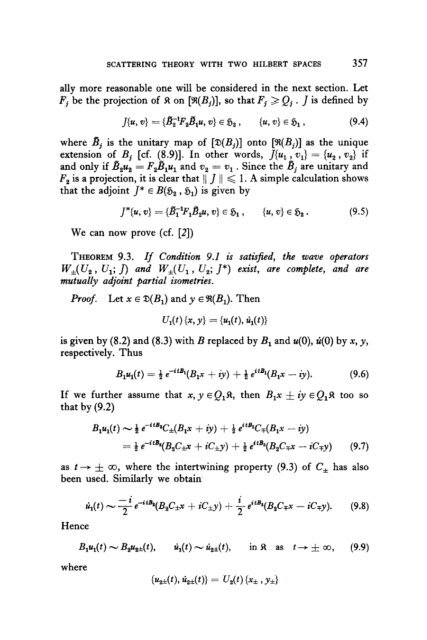On the Characters and the Plancherel Formula of Nilpotent Groups ...
On the Characters and the Plancherel Formula of Nilpotent Groups ...
On the Characters and the Plancherel Formula of Nilpotent Groups ...
Create successful ePaper yourself
Turn your PDF publications into a flip-book with our unique Google optimized e-Paper software.
SCATTERING THEORY WITH TWO HILBERT SPACES 357<br />
ally more reasonable one will be considered in <strong>the</strong> next section. Let<br />
Fi be <strong>the</strong> projection <strong>of</strong> a on [‘X(Bj)], so that Fi > Qi . J is defined by<br />
Jh 4 = Qm$% 4 E 52 > {u, 4 E -51 9 (9.4)<br />
where lPj is <strong>the</strong> unitary map <strong>of</strong> [3)(Bi)] onto [X(Bj)] as <strong>the</strong> unique<br />
extension <strong>of</strong> Bi [cf. (8.9)]. I n o<strong>the</strong>r words, J{ul , q} = {uz , w2} if<br />
<strong>and</strong> only if &u, = Fz&ul <strong>and</strong> va = v, . Since <strong>the</strong> ~j are unitary <strong>and</strong><br />
F, is a projection, it is clear that 11 J 11 < 1. A simple calculation shows<br />
that <strong>the</strong> adjoint J* E B(& ,a,) is given by<br />
I*&, 4 = @?@b, 4 E -5, ,<br />
We can now prove (cf. [2])<br />
THEOREM 9.3. If Condition 9.1 is satis$ed, <strong>the</strong> wave operators<br />
W,( U, , UI; J) <strong>and</strong> W,( U, , Uz; J*) exist, are complete, <strong>and</strong> are<br />
mutually adjoint partial isometrics.<br />
Pro<strong>of</strong>. Let x E D(B,) <strong>and</strong> y ~%t(Bi). Then<br />
G(t) c% Y> = {Ul(Q 4(t)><br />
is given by (8.2) <strong>and</strong> (8.3) with B replaced by B, <strong>and</strong> u(O), G(O) by X, y,<br />
respectively. Thus<br />
B&t) = + eeitB1(Blx + iy) + 8 eft4(B,x - iy). (9.6)<br />
If we fur<strong>the</strong>r assume that x, y E QiR, <strong>the</strong>n B,x f. iy E QI~ too so<br />
that by (9.2)<br />
B1ul(t) N 4 eeftsaC*(Blx + iy) + Jj eitB2C~(B,x - iy)<br />
= 4 e-ftBa(B,Cjyc + i&y) + 3 eftBa(B&x - i&y) (9.7)<br />
as t -+ f co, where <strong>the</strong> intertwining property (9.3) <strong>of</strong> C, has also<br />
been used. Similarly we obtain<br />
Hence<br />
4(t) - 7j- - ’ e-f’Ba(B2Cjgc + i&y) + + e’tBa(B,CTx - iC,y).<br />
(9.8)

















